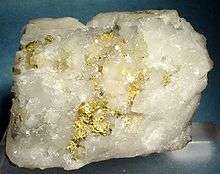Gold Hill (Nevada County, California)
| Gold Hill | |
|---|---|
 Location of Gold Hill in California | |
| Location |
Jenkins Street and Hocking Avenue Grass Valley, California |
| Coordinates | 39°12′47″N 121°4′9″W / 39.21306°N 121.06917°WCoordinates: 39°12′47″N 121°4′9″W / 39.21306°N 121.06917°W |
| Built | 1850 |
| Architect | George Knight |
| Official name: Site of one of the first discoveries of quartz gold in California | |
| Reference no. | 297[1] |
Gold Hill, in Grass Valley, California, was the site of one of the first discoveries of quartz gold[2] in California. While quartz gold was also found in other areas of Nevada County, California during the same time, it is this find near Wolf Creek that led to quartz-mining frenzy and subsequent creation of the Gold Country quartz-mining industry. The location is honored as a California Historical Landmark.
History
George Knight (sometimes known as McKnight) was a California Gold Rush miner. In October 1850, he was on a Grass Valley hillside when he came across an outcropping of white quartz rock laced with yellow. He pounded the rock with a cast iron skillet and hammer, then washed out the gold. Searching for more gold in the same spot, he dug down into the outcropping and found a 4 inches (10 cm) gold vein. His find was announced by another miner, George Crandall (1825–1908), who ran down to Boston Ravine, a small settlement nearby, with the news.[3][4]
Knight named the location Gold Hill and his claim became the Gold Hill Mine. He and friends constructed a crude stamp mill made out of the local forest's pine tree logs and equipped it with metal boots. The contraption was propelled by Wolf Creek's rushing water.
By March 1851, there were 150 buildings in the area, including hotels, saloons, stores, and even the first school.[5] Before the end of the year, thousands of people had moved to Grass Valley and neighboring Nevada City, California.[6]
While Gold Hill Mine produced $4,000,000 between 1850–1857, it "pinched out" by 1864 and closed.[7]
A 1940 geological survey of the Gold Hill Quartz Mine reported the host rock to be Diabase and Granodiorite and the mineral list showed gold, pyrite, and quartz.[8]
Historical landmark
The site is honored as California Historical Landmark number 297.[1] The plaque, located on the southwest corner of Jenkins Street and Hocking Avenue in Grass Valley reads:
| “ |
This tablet commemorates the discovery of gold-bearing quartz and the beginning of quartz mining in California. The discovery was made on Gold Hill by George Knight in October 1850. The occurrence of gold-bearing quartz was undoubtedly noted here and elsewhere about the same time or even earlier, but this discovery created the great excitement that started the development of quartz mining into a great industry. The Gold Hill Mine is credited with a total production of $4,000,000 between 1850 and 1857.[9] |
” |
References
- 1 2 "Discovery of Gold at Gold Hill". Office of Historic Preservation, California State Parks. Retrieved 2012-10-10.
- ↑ Hittell, John Shertzer (1861). Mining in the Pacific States of North America. San Francisco: J. Wiley. p. 124. ISBN 0-665-16737-7.
- ↑ Walker, Dale L. (2002). Eldorado : the California Gold Rush. New York: Macmillan. p. 255. ISBN 0-312-87833-8.
- ↑ Minch, Patricia L. (2008-07-28). "The search for George Crandall". The Union. Retrieved 2008-08-18.
- ↑ "Town History". Retrieved 2008-08-20.
- ↑ "Mining". grassvalleychamber.com. Retrieved 2008-08-20.
- ↑ Baumgart, Don (2002). "Empire Mine Evolves From Accident to Prominence". ncgold.com. Retrieved 2008-08-18.
- ↑ Logan, C.A. (1941). "Gold Hill Quartz Mine, Grass Valley, Nevada Co., California, USA". Journal of Mines and Geology. Mindat.org. 37 (3, PL. 3). Retrieved 2008-08-20.
- ↑ "No. 297 Site of One of the First Discoveries of Quartz Gold in California". California State Historical Landmarks in Nevada County. California Environmental Resources Evaluation System. Retrieved 2008-12-16.
